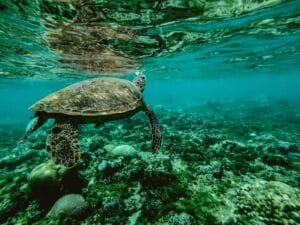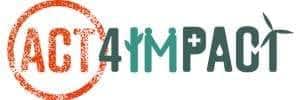The Olympics are one of the most prestigious global events, eagerly awaited by athletes and sports aficionados alike. While athletes strive for glory and a podium finish, host nations and cities aim to gain international prestige through the successful delivery of the Games. To achieve this, they often focus on large-scale infrastructure, including stadiums, athlete villages, and improved public transport. However, one of the most critical yet frequently overlooked aspects is water quality. This article is the first in a series examining Brisbane’s water quality challenges and their influence on Olympic preparations through the lens of thrivability, a systems-based framework grounded in science, regeneration, and long-term well-being.
the connection between water quality and olympic success
Poor water quality can not only tarnish the reputation of the host city but also expose both athletes and the general public to serious health risks. For events such as rowing, open-water swimming, sailing, and the triathlon, clean and safe water is essential for protecting athletes’ health and optimising performance.
Visualisation of environmental focus in news coverage during the year preceding the Olympics.
Source: THRIVE Project, 2025
Neglecting this issue could result in negative media coverage, undermining the host city’s efforts to project competence and earn global admiration. This interplay between water quality and Olympic success was evident in the Paris 2024 Games. An analysis of Olympics-related news articles from the year before revealed that nearly a quarter focused on environmental issues, mainly aquatic concerns like coral health in Tahiti (AP News, 2023) and water quality in the Seine River (RTÉ, 2024). Several reports highlighted the postponement of the men’s triathlon and incidents of gastrointestinal illnesses among athletes, raising concerns about the river’s suitability (RTE, 2024). These developments underscore the critical importance of water quality in protecting athlete health and ensuring the smooth execution of Olympic events. More broadly, they highlight the importance of respecting nature’s limits and allowing ecosystems to regenerate, a principle embodied in the THRIVE Framework’s Foundational Focus Factor (FFF) of Strong Sustainability.
Why Brisbane’s Waterways Are Under the Microscope Ahead of the 2032 Olympics
Brisbane’s waterways are under increased scrutiny as the city prepares to host the 2032 Olympic and Paralympic Games, with significant attention on environmental safety, athlete welfare, and long-term sustainability. Brisbane has committed to delivering the first “climate-positive” Olympics, aiming to reduce emissions and enhance ecological outcomes. Water quality monitoring is a critical component of these preparations. The Brisbane City Council conducts regular testing for microbial contamination at various recreational sites along the Brisbane River and Moreton Bay, focusing on bacteria levels to ensure public safety. Given that microbial contamination is interconnected with social, ecological, and infrastructural systems, addressing it effectively requires a Systems Thinking approach under the THRIVE Foundational Focus Factors (FFFs), ensuring that both public health and ecological concerns are managed as the city readies itself for the global spotlight.
Enterococci: An indicator of water quality
What are enterococci?
Enterococci are bacteria that are commonly found in various habitats, including the gastrointestinal tract (GIT) of humans and nearly all terrestrial animals, ranging from mammals and reptiles to birds and insects. In addition, they are commonly found in plants, soil, sediments, freshwater, and marine ecosystems, as well as in numerous types of food products, such as dairy items, fermented vegetables, meats, fish, and seafood (Cattoir, 2022).
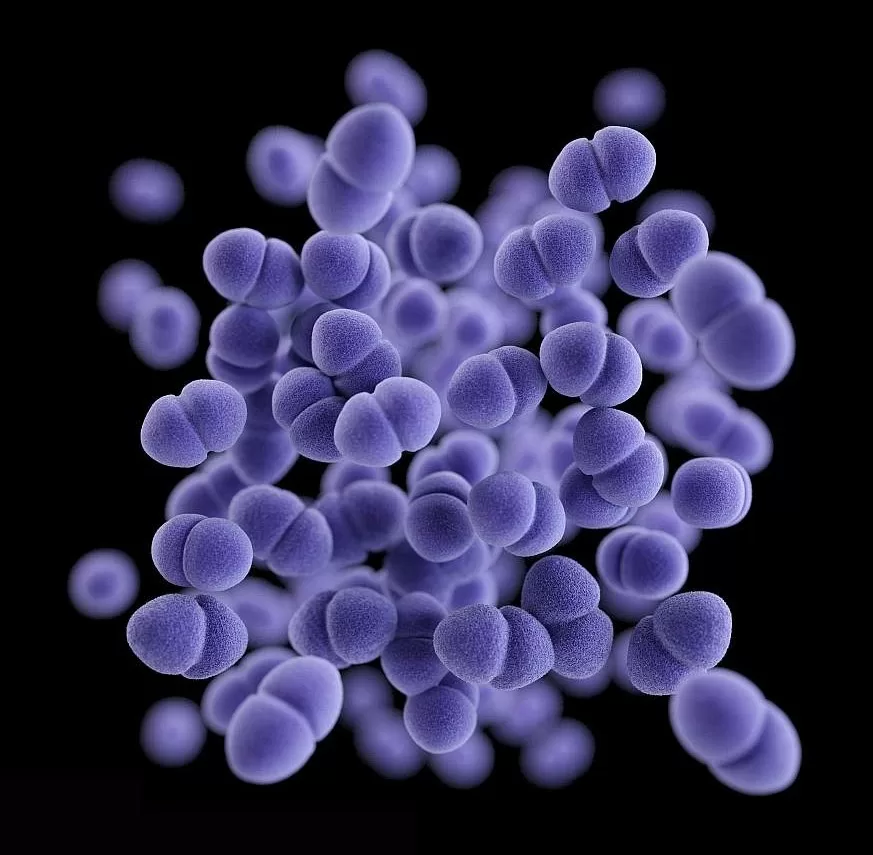
Enterococci bacteria. This particular picture shows drug-resistant bacterial species.
Source: CDC.gov, 2024
Why to choose enterococci as an indicator of water quality
Enterococci are Gram-positive bacteria, which means they have thick, protective cell walls (Rohde M, 2019) that make them resilient to environmental stresses, such as temperature fluctuations, pH variations, high concentrations of sodium chloride (salt), bile salts (digestive intestinal chemicals), and even desiccation (Cattoir, 2022). Their presence in water indicates faecal contamination from sources such as stormwater run-off, sewage leaks, tides, and land use and is therefore symptomatic of broader issues, such as poorly designed urban infrastructure. Their persistence, coupled with their connection to multiple underlying issues, makes them a Complex Wicked Problem under the THRIVE Framework’s Foundational Focus Factors (FFFs) and a valuable metric for assessing water quality.
Accordingly, Australian water quality guidelines for Enterococci have been incorporated as a central parameter (Waterquality, 2018). This inclusion is essential, as it plays a key role in evaluating the environmental health and safety of surface waters across various aquatic ecosystems. These bacteria serve as a surrogate for a wide range of contaminants that may enter waterways from sewage or animal waste, offering a cost-effective and scientifically robust means to evaluate pollution levels (McClary et al., 2019).
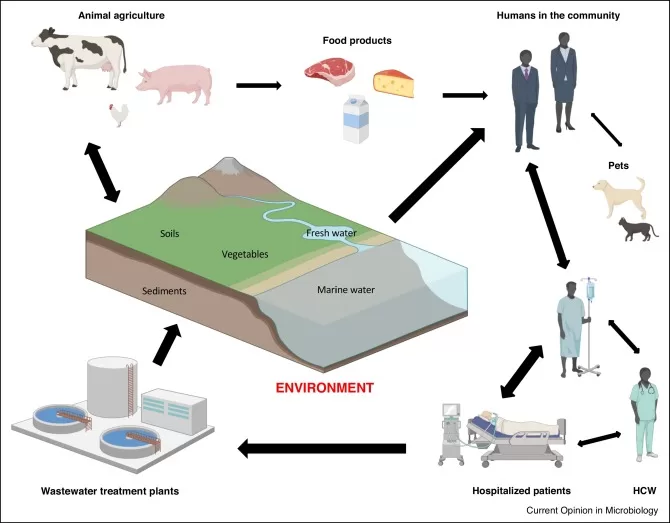
Possible routes for the transfer of Enterococci among different reservoirs.
Source: Cattoir, 2022
Persistently high CFU levels point to chronic pollution issues, such as leaky sewage infrastructure or diffuse pollution from urban and agricultural sources. Holistic measures that integrate social, economic, and environmental considerations, an embodiment of Integral Thinking, not only help reduce Enterococci proliferation but also help rejuvenate the natural microbial balance. Such measures include restoration and conservation of wetlands, stormwater treatment systems, and improved land-use practices (Rani et al., 2024). Restoring natural systems and enabling water reuse reflects a Regenerative Economy, another THRIVE Framework FFF, where human activities go beyond minimising harm to actively replenishing ecosystems and fostering conditions for both nature and society to thrive.
From Health Hazard to National Headache: The Public Safety Implications
Enterococci: From Gut Allies to Global Health Threats
Enterococci, typically harmless gut commensals, can become invasive under specific conditions. What this means is that when Enterococci are confined in the gut (gastrointestinal tract), they act as normal flora. Normal flora helps the body to keep a balance of harmful bacteria. When it breaks out to other areas, to sterile areas (blood, urine, wounds, etc), Enterococci can cause serious infections. Enterococci can thrive in diverse environments like soils, water, food, and animal feed. Once considered harmless gut bacteria, they have become major hospital pathogens owing to their resilience and ability to acquire antibiotic resistance. Enterococcus faecalis and E. faecium have evolved into dangerous, drug-resistant pathogens (Ayobami et al., 2020).
The Medical Toll: Diseases, Symptoms, and Prevalence
Enterococci don’t limit themselves to one body system. They invade widely and can attack aggressively.
1. Urinary tract infections
Enterococcal Urinary tract infections (UTIs) affect all age groups globally. Over 400 million cases and 200,000 deaths were reported in 2019. Moreover, rising infection rates, mortality, and healthcare costs exceeding USD$2.8 billion in the U.S. alone underscore the growing global burden and, therefore, the urgent need for effective interventions (Codelia-Anjum et al., 2023).
Urinary tract infections (UTIs) are common, especially in catheterised patients. Symptoms include painful urination, urgency, and lower abdominal pain (Kaur & Kaur, 2021). Furthermore, Enterococcus faecalis causes difficult-to-treat UTIs, particularly in catheterised or immunocompromised individuals. Its ability to form biofilms, survive intracellularly, and resist antibiotics increases the chance of a chronic infection. Moreover, key genes like Enterococcal polysaccharide antigen (Epa) and Endocarditis- and biofilm-associated pili (Ebp) promote adhesion, immune evasion, and long-term persistence throughout the urinary tract (Daca & Jarzembowski, 2024).
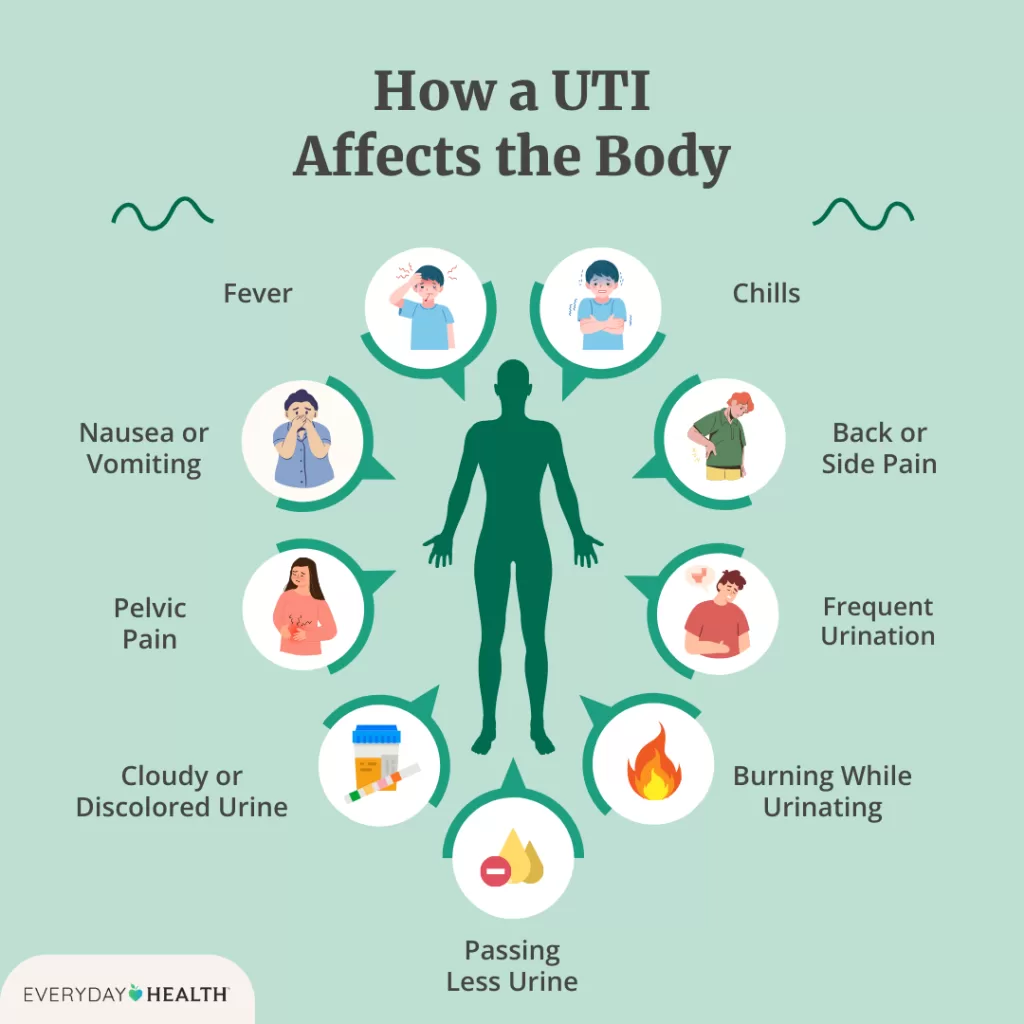
Source: EverydayHealth
2. Blood Infections
Enterococci can cause bacteremia (the presence of bacteria in the bloodstream), quickly escalating to life-threatening sepsis. Symptoms include fever, chills, and rapid decline. Vancomycin-resistant E. faecium (sub-clusters 2C and 3F) increasingly cause bloodstream infections in Australia, leading to sepsis (Lee et al., 2020). These strains’ high resistance and virulence demand urgent genomic surveillance. Alarmingly, such infections can be fatal, with mortality rates reaching 33.5% in some cases, underscoring the clinical threat (Brinkwirth et al., 2021).
3. Heart infections
Endocarditis (a rare and potentially fatal infection of the inner lining of the heart) often strikes those with heart conditions. It causes fatigue, fever, and heart murmurs. Treatment is prolonged and invasive (Hao, 2024). Enterococcus faecalis is now a leading cause of infectious Endocarditis, especially in older adults. It crosses the gut wall, forms biofilms, and expresses virulence factors like Epa, Aggregation Substance (AS), and Ebs, triggering immune responses and potentially fatal heart valve infections (Daca & Jarzembowski, 2024). Epa, AS, and Ebs are Enterococcus faecalis surface structures that help it stick to tissues, form biofilms, and evade the immune system. Patients often present vague symptoms like anaemia, which delays diagnosis. Frequently, heart failure prompts detection. Despite high need, only 40% undergo surgery, as frailty often prevents intervention. Notably, E. faecalis dominates Transcatheter Aortic Valve Implantation (TAVI)-related Endocarditis cases today (Herrera-Hidalgo et al., 2023).
4. Wound Infections
Wound infections often result in swelling, pus formation, and progressive skin breakdown. Moreover, Enterococcus invades damaged tissue and, in turn, forms protective biofilms that obstruct healing and shield it from treatment (Xu et al., 2024). In surgical wounds, it frequently coexists with other microbes; consequently, inflammation worsens and infection severity increases (Kao et al., 2023). Additionally, Enterococcus suppresses neutrophil responses, which typically eliminate bacteria, thereby allowing deeper tissue invasion (Tan et al., 2024). As a result, these infections not only delay recovery but also elevate healthcare costs and risk of complications. If left undetected or poorly treated, Enterococcal wound infections can quickly escalate into severe, potentially life-threatening conditions such as sepsis.
These infections are hard to treat. This is because Enterococci rapidly acquire resistance genes through mobile elements and lack of CRISPR-Cas defence (Cattoir, 2022). CRISPR-Cas can be thought of as a bacterial immune system that helps block foreign DNA, such as resistance genes, from entering. It works by recognising and cutting up the DNA of invading elements such as plasmids (small, circular pieces of DNA that can move between bacteria) and viruses, thereby preventing bacteria from acquiring unwanted traits. Since Enterococci often lack this defence, they can easily collect resistance genes from their surroundings. Between 2012 and 2018, Vancomycin-Resistant Enterococcus faecium (VREFm) prevalence more than doubled in Europe (Ayobami et al., 2020).
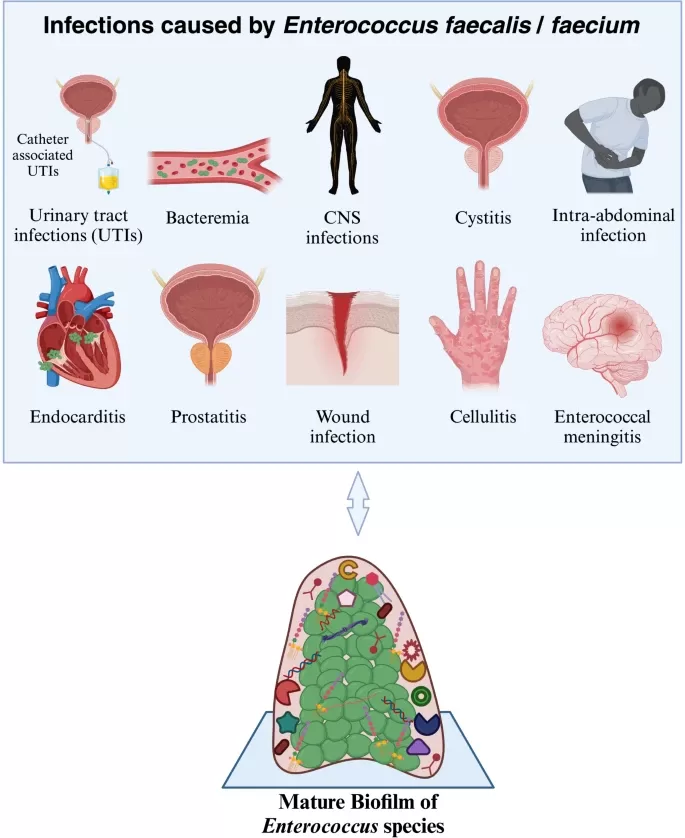
Source: Link Springer
Health Impacts from Waterborne Exposure
Recreational exposure poses major health risks
- Swimmers may ingest bacteria. This may result in gastrointestinal illness, vomiting, diarrhoea, and stomach cramps. Enterococcus species can contaminate meat, dairy, and ready-to-eat foods, spreading antibiotic resistance. Their resilience in harsh conditions and production of toxic amines pose risks for food spoilage, allergic reactions, and reduced antibiotic effectiveness in human infections (Beata Krawczyk et al., 2021).
- Contact with water leads to skin infections, rashes, and boils. In some, cellulitis develops.
- Ear, eye, and respiratory infections hit children hardest. Immunocompromised people face even greater danger.
- In rare cases, bacteria enter open wounds. The outcome can be fatal.
A Crisis in Motion
Brisbane faces an urgent threat as drug-resistant Enterococci spread beyond hospitals into the environment, endangering entire communities. Unlike isolated clinical outbreaks, environmental exposure affects people, animals, and ecosystems, making containment far more complex. As resistant bacteria cross boundaries, the risk escalates. If we fail to act, Brisbane’s water quality will deteriorate, placing immense strain on the public health system. Clean water is not optional; it is a fundamental human right that supports health, economic vitality, and international credibility.
Conclusion and Call to Action
With Brisbane set to host the Summer Olympics in 2032, ensuring clean, safe waterways isn’t just a public health priority; it’s a matter of global reputation. Enterococci levels in our waterways must be addressed through data-driven strategies informed by successful case studies from around the world. But before action comes understanding. In our next article, we will dive deeper into the patterns in Brisbane’s Enterococci data and uncover what the numbers reveal. Join us in exploring the evidence that can lead to cleaner, healthier water for all.
Achieving THRIVE goals
The United Nations’ 17 Sustainable Development Goals (UN’s SDGs) are an urgent global call to tackle the most pressing challenges of our time. Safeguarding Brisbane’s waterways aligns with several of these SDGs, but each comes with its own blind spots:
SDG6: Clean Water and Sanitation emphasises infrastructure for water access and pollution control, but does not clearly link water quality to human health outcomes.
SDG3: Good Health and Well-Being prioritises medical interventions, health infrastructure, and service delivery, but under-represents environmental health.
SDG11: Sustainable Cities and Communities is focused on development and infrastructure, while largely overlooking the ecological dimensions of urbanisation.
SDG14: Life Below Water centres on the integrity of marine ecosystems, but pays limited attention to the implications for human health and well-being.
Taken together, the UN’s SDGs emphasise the individual components needed for healthy ecosystems but often fall short of addressing the complex interplay between them. Tackling these SDGs in isolation can create conflicts among goals. For example, ‘SDG14: Life Below Water’, which focuses on the conservation of marine ecosystems, could conflict with ‘SDG11: Sustainable Cities and Communities’, which prioritises inclusive urban development but does not explicitly account for aquatic health.
THRIVE’s Foundational Focus Factors (FFFs), Systems Thinking, Regenerative Economy, Complex Wicked Problems, Integral Thinking, and Strong Sustainability, provide a cohesive, holistic framework to address these challenges, ensuring that the pursuit of individual objectives supports rather than undermines broader ecological and societal outcomes.
A Thrivable Framework
As Brisbane prepares to host the 2032 Olympics, water quality has understandably become a major focus, closely linked to public health, environmental sustainability, and the city’s global reputation. First and foremost, the THRIVE Framework helps us approach this challenge from multiple angles.
1. System thinking
Systems Thinking considers how sewage leaks, stormwater runoff, tides, and human behaviour combine to raise Enterococci levels, ensuring interventions address the entire chain of contributing factors. This is important because tackling only one source risks leaving the problem unresolved.
2. REGENERATIVE ECONOMY
By aligning with a Regenerative Economy, waste is transformed into resources, for example, repurposing treated sewage for urban irrigation or energy generation, thereby closing the loop where both people and ecosystems can thrive, even amidst the pressures of hosting large-scale events like the Olympics.
3.COMPLEX WICKED PROBLEM
Complex Wicked Problem recognition encourages adaptive, multi-pronged strategies to manage bacteria that are both resilient and resistant to antibiotics. This is vital because static, one-off solutions cannot cope with changing environmental conditions.
4. INTEGRAL THINKING
Integral Thinking brings together urban planners, environmental scientists, public health experts, and community stakeholders to create cohesive, cross-sector responses. This is a critical element of aligning resources and expertise toward sustainable water quality improvements.
5. STRONG SUSTAINABILITY
Strong Sustainability focuses on protecting and regenerating water systems as essential natural capital, rather than merely meeting short-term needs. This is important for ensuring healthy ecosystems and safe waterways for generations after the 2032 Olympics.
Ultimately, by embracing these key THRIVE principles, Brisbane has the opportunity to transform a public health risk into a world-leading example of regenerative infrastructure, smart governance, and environmental stewardship, ensuring not just a successful Olympic Games but a lasting legacy for generations to come. To learn more about thrivability, head to the THRIVE website. Here, you can find published articles, whitepapers, and presentations on a range of thrivable topics. More resources can also be found on the THRIVE YouTube channel. Be sure to sign up for the newsletter and attend the monthly webinars. To contribute more to THRIVE, please volunteer.




